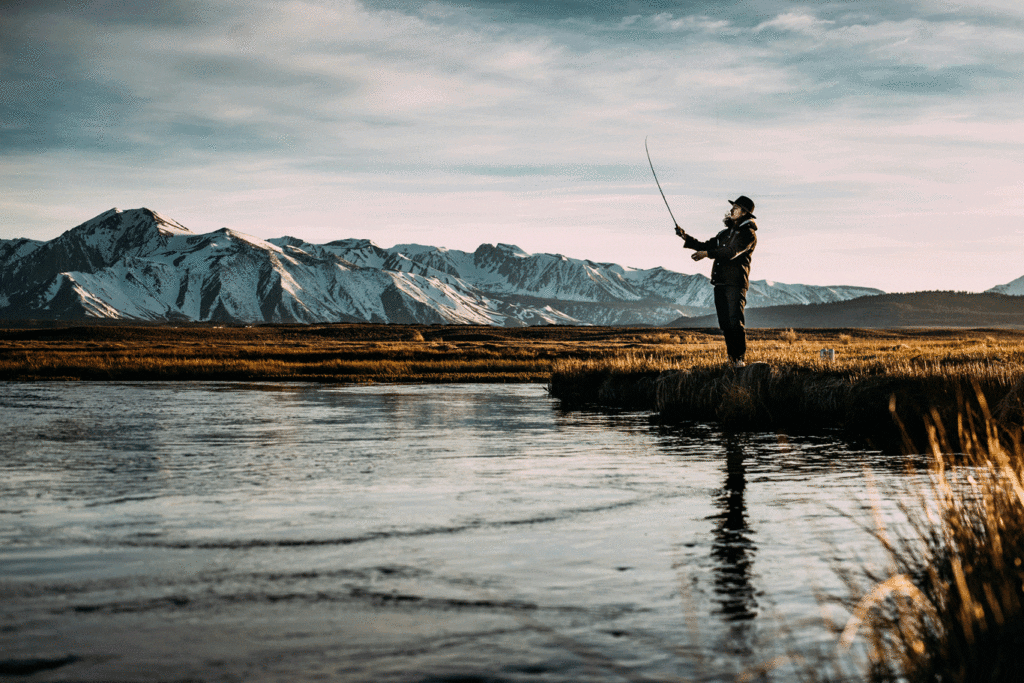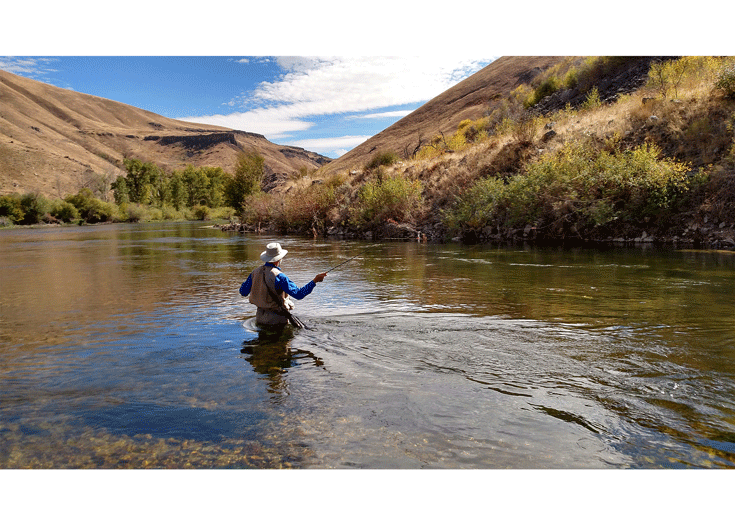
Fly fishing is not just a hobby; it’s an art form that requires patience, skill, and a deep understanding of the aquatic environment. Here’s a step-by-step guide on how to fly fish, whether you’re a beginner or looking to refine your technique:
1. Gear Up:
- Fly Rod: Choose a fly rod that suits the type of fishing you’ll be doing. For Utah’s rivers and streams, a 9-foot rod with a weight of 4 to 6 is a good all-around choice.
- Reel: Select a reel that matches the weight of your rod and has a smooth drag system to handle large fish.
- Fly Line: Match your fly line weight to your rod and reel setup. Weight-forward floating lines are versatile and suitable for most situations.
- Leader and Tippet: Use a tapered leader to connect your fly line to your fly. Add tippet material to the end of the leader for added stealth and strength.
- Flies: Select flies that imitate the insects present in the water you’ll be fishing. Common patterns include dry flies, nymphs, and streamers.

2. Understand Casting Techniques:
- Basic Cast: Hold the rod with your dominant hand and the line with your non-dominant hand. With a smooth motion, raise the rod tip, pause briefly, and then bring the rod tip forward, releasing the line at the right moment to create a controlled loop.
- Roll Cast: Ideal for tight spaces or when dealing with obstacles behind you, the roll cast involves sweeping the rod tip in a semicircle motion to lift the line off the water and propel it forward.
- False Cast: Use false casts to dry off your fly, change direction, or adjust your distance. This involves casting the line back and forth without allowing the fly to touch the water.
3. Learn to Read the Water:
- Identify Currents: Look for seams, riffles, and eddies where fish congregate to feed and seek shelter.
- Observe Insect Activity: Pay attention to the surface of the water for signs of insect hatches, such as rising fish or floating debris.
- Understand Structure: Fish are often found near structure, such as rocks, logs, and submerged vegetation, where they can ambush prey or find protection from predators.
4. Present Your Fly:
- Approach Stealthily: Fish can be easily spooked, so approach the water quietly and avoid making sudden movements.
- Cast Upstream: Present your fly upstream of the target area and let it drift naturally with the current. This mimics the natural movement of insects and increases your chances of a strike.
- Mend Your Line: Use mends to control the drift of your fly and prevent drag, ensuring a natural presentation.

5. Set the Hook and Play the Fish:
- Set the Hook: When you feel a strike, respond with a swift but controlled hook set by raising the rod tip sharply.
- Play the Fish: Keep tension on the line and let the fish run if needed. Use the bend of the rod to tire out the fish while maintaining control.
6. Practice Conservation:
- Handle Fish Gently: Wet your hands before handling fish to protect their delicate slime coat. Use barbless hooks and avoid removing fish from the water for extended periods.
- Practice Catch and Release: Consider releasing your catch to ensure the sustainability of fish populations for future generations.
By mastering these techniques and principles, you’ll be well-equipped to embark on a successful fly fishing adventure in the beautiful waters of Utah. Remember to respect the environment, practice ethical angling practices, and savor every moment spent connecting with nature.
Where to fly fish in Utah
Utah, known for its stunning landscapes and diverse ecosystems, offers anglers a paradise for fly fishing. With its abundance of rivers, streams, lakes, and reservoirs, the state provides endless opportunities to reel in trophy trout and immerse oneself in the beauty of nature. Whether you’re a seasoned angler or a beginner looking to cast your first line, this ultimate guide to fly fishing in Utah will navigate you through the best spots to explore.

1. Provo River
Nestled in the scenic Provo Canyon, the Provo River is a renowned destination for fly fishing enthusiasts. Divided into the Upper Provo and Lower Provo sections, this river offers a variety of fishing experiences. The Upper Provo, with its wild brown trout and rainbow trout, provides a challenging yet rewarding adventure. The Lower Provo, on the other hand, boasts abundant insect life, making it an ideal spot for catching trout year-round.
2. Green River
Flowing through the picturesque Flaming Gorge National Recreation Area, the Green River is celebrated for its crystal-clear waters and prolific trout population. Here, anglers can expect to encounter hefty brown trout, rainbow trout, and cutthroat trout. The section below Flaming Gorge Dam, known as the “A” section, is particularly famous for its trophy-sized fish and breathtaking scenery, making it a must-visit destination for fly fishermen.
3. Strawberry Reservoir
Situated in the Uinta National Forest, Strawberry Reservoir is a vast expanse of water teeming with aquatic life. This renowned fishery is home to an abundance of rainbow trout, cutthroat trout, and kokanee salmon. Anglers can explore the reservoir’s shoreline or venture out on a boat to find their perfect fishing spot. With its stunning mountain backdrop and excellent fishing opportunities, Strawberry Reservoir offers an unforgettable fly fishing experience.
4. Logan River
Flowing through Logan Canyon in northern Utah, the Logan River is a hidden gem for fly fishing enthusiasts. This pristine mountain stream is characterized by its clear waters and wild trout population. Anglers can expect to catch brown trout, rainbow trout, and cutthroat trout while surrounded by towering cliffs and lush vegetation. Whether you’re wading through its riffles or casting from the banks, the Logan River promises a tranquil and rewarding fishing adventure.
5. Provo River Middle Section
The Middle Provo River, located between Jordanelle and Deer Creek reservoirs, is another prime destination for fly fishing in Utah. This section of the river offers a perfect blend of scenery and fishability, making it popular among anglers of all skill levels. With its abundant insect hatches and healthy trout population, including brown trout and rainbow trout, the Middle Provo provides an excellent opportunity for both dry fly and nymph fishing.
6. Fremont River
Flowing through the heart of Capitol Reef National Park, the Fremont River offers a unique fly fishing experience amidst stunning desert scenery. Anglers can explore its clear waters for brown trout and rainbow trout while marveling at the park’s towering cliffs and rock formations. The Fremont River’s diverse habitat and secluded beauty make it a favorite among fly fishermen seeking a one-of-a-kind adventure in Utah’s wilderness.
7. Uinta Mountain Lakes
For anglers seeking solitude and pristine wilderness, the Uinta Mountains boast numerous high-elevation lakes teeming with trout. These remote alpine gems offer a tranquil escape and fantastic fishing opportunities for those willing to hike in. Whether you’re casting a line into a serene mountain lake or exploring a hidden stream, the Uinta Mountains provide a wilderness fishing experience like no other.

In conclusion, Utah’s diverse landscape offers a wealth of fly fishing opportunities for anglers of all interests and skill levels. From the rushing rivers of Provo and Logan to the serene waters of Strawberry Reservoir and the high-elevation lakes of the Uinta Mountains, the state’s waters are teeming with trout waiting to be caught. So grab your fly rod, pack your gear, and embark on an unforgettable fly fishing adventure in the beautiful state of Utah.
Fly fishing is incredibly fun and satisfying. I rarely do it because I tend to be very competitive with my fishing buddies and traditional fishing give me better results. But I think fly fishing might actually be more enjoyable in certain scenarios.